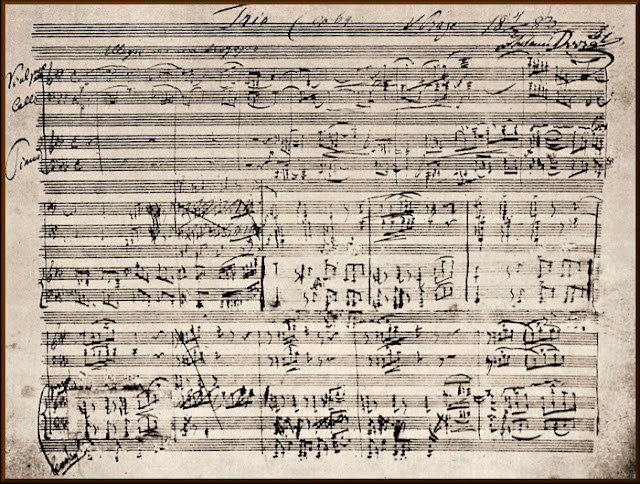 |
| Violinist Geneva Lewis, cellist Michael Kaufman, and pianist Marisa Gupta play Schumann and Brahms at the Mason Home. |
REVIEW
Lewis/Kaufman/Gupta trio play Schumann and Brahms, Mason House, Mar Vista
JOHN STODDER
The Mason Home Concerts have been a grievous absence of the pandemic, a kind of guilty displeasure, small in the realm of Covid tragedies but, for those fortunate enough to have experienced them, irreplaceable in the heart. So it was emotionally an uplift to return for a chamber music program for the first time since early 2020, to chat with audience regulars again, to immerse oneself in host and impresario Todd Mason’s gracious hospitality, and above all to once again hear beautifully-chosen chamber music in a room designed for its presentation.
This being Southern California, the Mason Home is an indoor/outdoor venue. Musicians and audience were masked inside, but permitted to go unmasked out on the patio, enjoying individually wrapped snacks and beverages on a cool but not cold winter’s night. All attendees were required to prove double-vaccination, which gave a further margin of comfort, allowing us to leave coronavirus trauma behind to focus on the music and fellowship with regular attendees.
 |
| Todd Mason. |
The opener he chose, Robert Schumann’s 6 Studien in kanonischer Form, Op. 56 (1845), couldn’t have been more appropriate for the moment. This is one of three sets of pieces Schumann wrote to explore contrapuntal music, coinciding with a time when severe depression and “nervous prostration” had driven him from his conservatory post in Leipzig to Dresden. In part, these compositions were inspired by a piece of equipment he brought with him: a pedal attachment for the piano that was used for conservatory training of organ students. The version we heard was arranged for piano trio.
 |
| Clara and Robert Schumann, c.1850. |
The trio, comprising violinist Geneva Lewis, cellist Michael Kaufman, and pianist Marisa Gupta, achieved an almost perfect aural balance, smartly cooperating with the Mason Home’s lively acoustics in subdued, empathetic playing that enabled each voice in the musical conversation to be heard without shouting, carefully controlled so that each movement’s harmonic resolution could sink in. It was as if we’d just been told a secret—a breathtakingly restrained performance that seemed mindful of the path of trauma that led us all into this room together to find musical relief.
 |
| Michael Kaufman. |
 |
| Geneva Lewis. |
After intermission, LA Opus' David J. Brown gave a talk on the lives of Robert Schumann, his brilliant pianist spouse Clara, and their friend Johannes Brahms, and the effects of Robert’s crippling mental illness on all of them. He spent his final years in a Bonn asylum after a suicide attempt that led him to warn Clara that he might be a danger to her. Perhaps for that reason, he was not allowed to see her, but Brahms was a regular visitor. This familial connection between all three was the perfect glide path into the program’s final performance, Brahms’ Piano Trio No. 2 in C major, Op. 87 (1880/1882).
 |
| The young Brahms, c.1855. |
Brahms’ persona had changed by the 1880s—now the mature, bearded composer rather than the handsome, rakish concert pianist of his younger days. Of the trio in C, he wrote to his publisher, "You have not yet had such a beautiful trio from me and very likely have not published its equal in the last 10 years." This four-movement Piano Trio No. 2 in C major was first performed in Frankfurt on a December night in 1882, doubtless a chillier evening than we experienced on this December night in 2021 in West Los Angeles.
 |
| Marisa Gupta. |
These Mason Home Concerts have been so missed by their fans, and much of the pleasure here was the communion of audience members together again, hearing this dynamic group of young musicians. Life is far from “back to normal” in LA or anywhere else, but perhaps we can all get through this pandemic if we have the occasional foray into live classical music to bring us back together.
---ooo---
Mason Home Concert, 3484 Redwood Ave., Mar Vista, CA 90066, 6 p.m., Saturday, December 4, 2021.
Images: The concert: Todd Mason; The Schumanns: Getty Images; Michael Kaufman: Davi Michael Photography, Inc.; Geneva Lewis: Motti Fang-Bentov; Brahms: Wikimedia Commons; Marisa Gupta: Yellow Barn.







